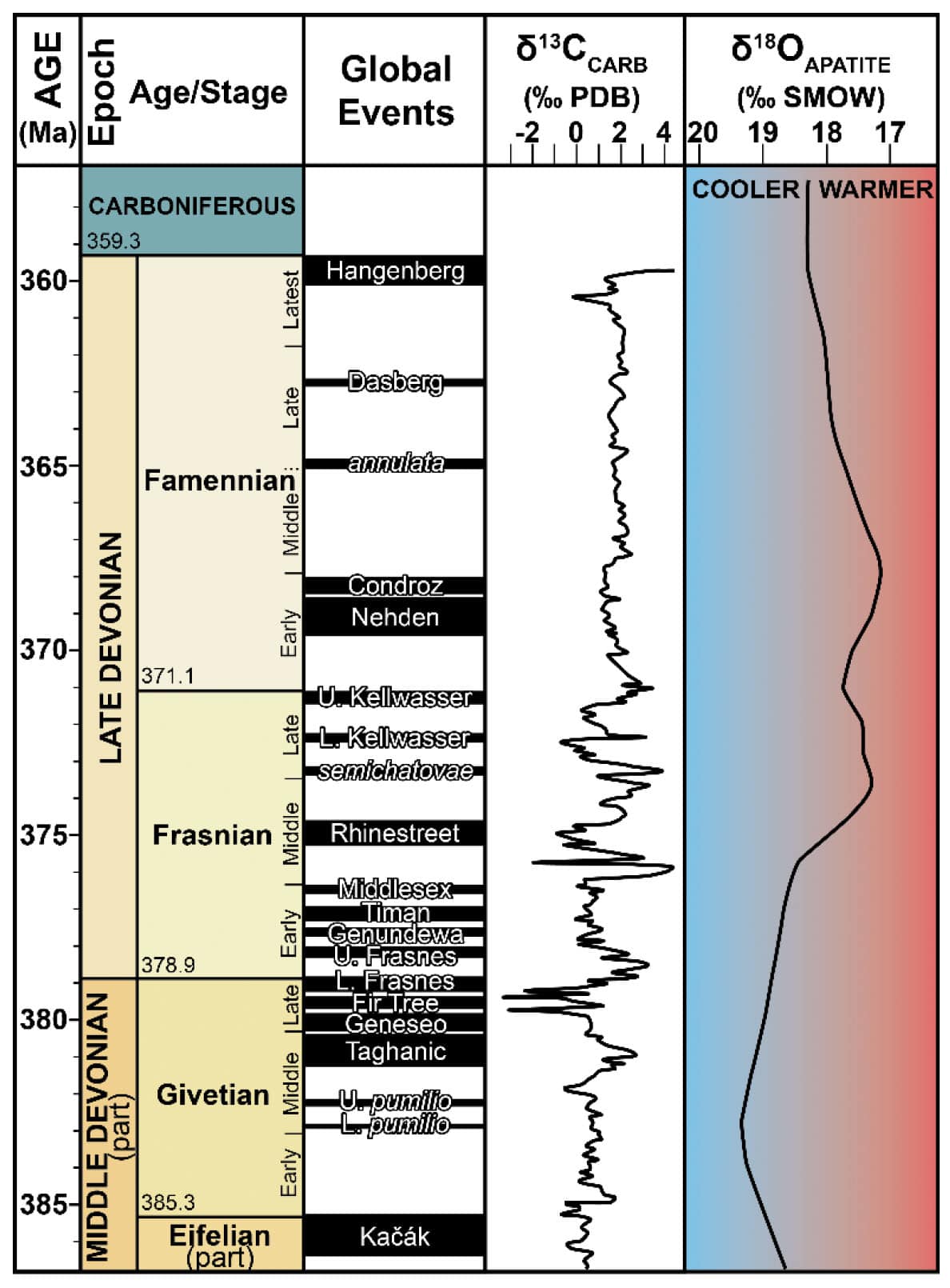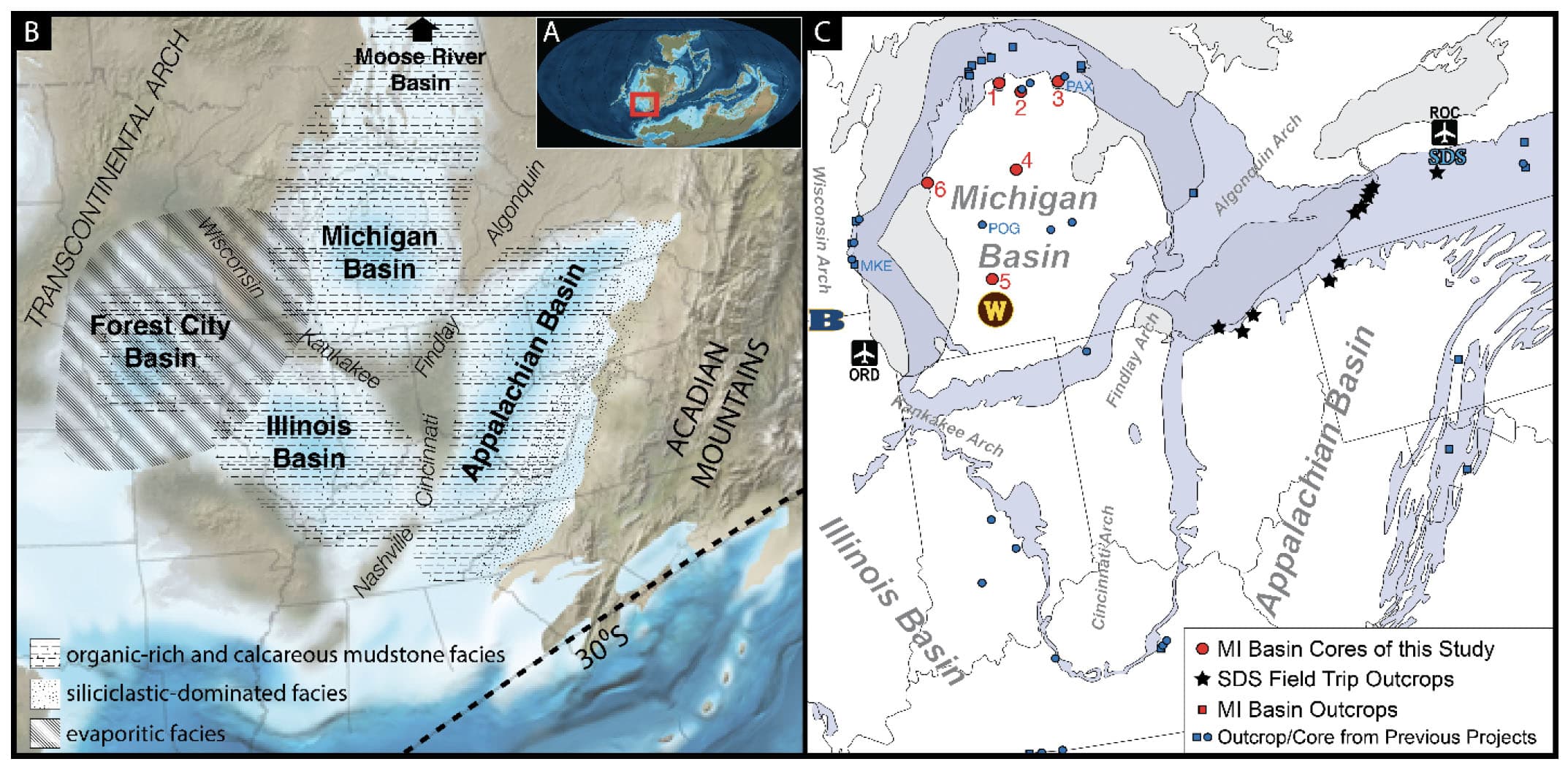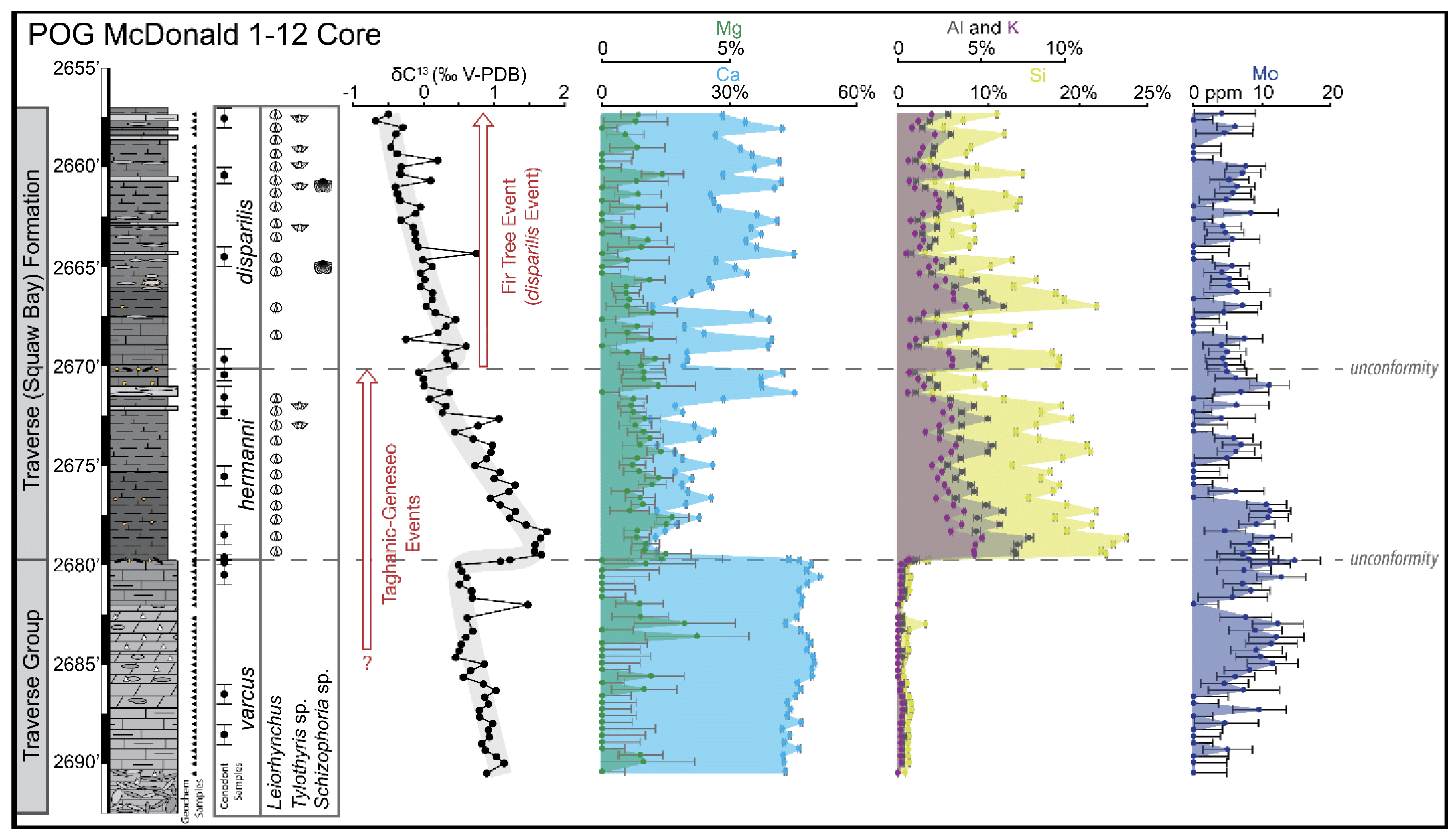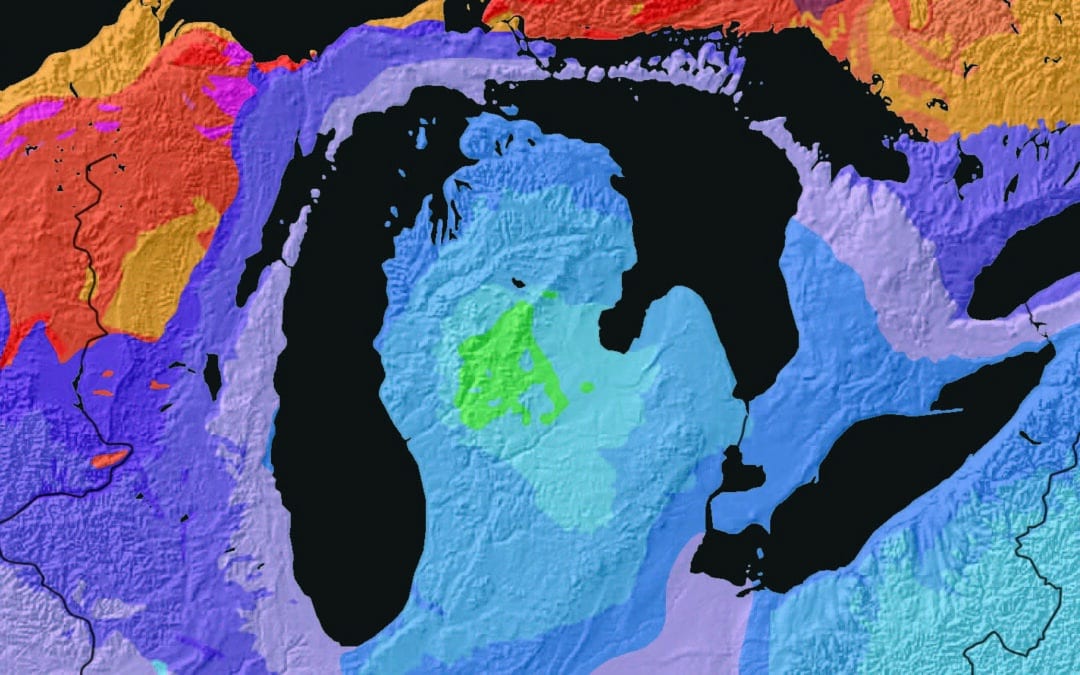Integrated Stratigraphic and Paleoenvironmental Study of the Middle-Late Devonian Carbonate to Black Shale Transition in the Michigan Basin
Overview: Devonian climate trends have long been studied within the context of biological change. For example, the End-Devonian glaciation is typically thought to be related to CO2-drawdown due to the evolution of forests during the Middle-Late Devonian (Algeo and Scheckler, 1998, and references therein). However, more recent paleoclimate reconstructions indicate that the Devonian climate story is more complex. Even though it has now been shown that the Middle Devonian was cooler than the end-Devonian and glacio-eustatic sea-level dynamics operated during the Middle Devonian (Fig. 1; Elrick et al., 2009, 2022; Joachimski et al., 2009), only Late and end-Devonian evidence for glaciation has been documented (Ettensohn et al., 2020). In order to better understand these long-term patterns, a current focus within the Devonian research community is the study of the repeated, short-duration, globally-recognized events that resulted in marine anoxia, extinctions, and carbon-cycle perturbations (Fig. 1; House, 2002; Becker et al., 2020; Brett et al., 2020), especially within the context of local environmental change and tectonics (Zambito et al., 2012; Chen et al., 2021). This Keck project is focused on recognizing these events, and reconstructing the environmental change associated with them, in Middle Givetian through Lower Famennian strata of the Michigan Basin (Figs. 1 and 2).
When: July 6 – August 2, 2023
Where: Western Michigan University, Kalamazoo, MI and Beloit College, Beloit, WI
Who: Nine students and project leaders, Dr. Jay Zambito, Beloit College, zambitoj@beloit.edu) and Dr. Peter Voice, Western Michigan University, peter.voice@wmich.edu
Recommended Courses: Sedimentology/Stratigraphy and Mineralogy.
Expectations and Obligations:
- Participation in all summer research activities (July 6 – August 2, 2023)
- Write an abstract and present a poster at the NC-SC Geological Society of America meeting in Springfield, MO, 21–23 April 2024.
- Write a short contribution (4-6 pages text + figures) to be published in the Proceedings of the Keck Geology Consortium 2024 Volume (first draft due Mid-February).
- Encouraged but not required: Use this work for the completion of a senior thesis (or equivalent) at your home institution.

Figure 1: Middle (in part) and Late Devonian Time Scale showing the timing and duration of global events, carbonate carbon isotopic excursions, and generalized paleoclimate trends based on oxygen isotopic analysis of conodont apatite; Adapted from Becker et al., 2020.
PROJECT DESCRIPTION
The Michigan Basin is one of four depocenters in the northeast and upper Midwest United States (Fig. 2). In the northern Appalachian Basin (New York State), Devonian strata are well exposed in an outcrop belt that is perpendicular to depositional strike of siliciclastic sediment input from the Acadian Mountains (Fig. 2); these strata are therefore not only better-studied than contemporaneous strata in the Michigan Basin, but New York strata are the type examples for which many global events are named (Fig. 1). However, the Appalachian Basin was also tectonically active at this time and local environmental change associated with basin subsidence and sediment supply often overprints global environmental changes (Zambito et al., 2012). Conversely, the Middle-Upper Devonian transition from Traverse Group shallow marine carbonates through the transitional Squaw Bay Formation to the Antrim Formation anoxic black shale in the Michigan Basin is unlikely the result of continental-margin tectonism (Fig. 2), and more accurately reflects the signal of global environmental change.
The Michigan Basin Devonian succession has a long history of lithostratigraphic study and basin-wide correlation, though there is recognition that the stratigraphic nomenclature originally defined with the limited outcrops available at the northern basin margin is not easily applied to the subsurface (Ehlers and Kesling, 1970; Kesling et al., 1974, 1976; Catacosinos et al., 2000; Wylie and Huntoon, 2003; Swezey et al., 2015). Furthermore, since Michigan Basin type-section outcrops are rare, stratigraphically short, and generally lack exposure of formation and member contacts (Zambito and Voice, personal field notes), and a variety of cores exist as a result of active oil and gas exploration (Swezey et al., 2015), this project will focus on the study and sampling of the extensive drill core available at the Michigan Geological Repository for Research and Education (MGRRE) at Western Michigan University (see Figure 2 for details). Additionally, this project will also involve study of the geologically contemporaneous Appalachian Basin Middle-Upper Devonian strata found in outcrops along the Lake Erie shoreline and creeks in Ohio, Pennsylvania, and New York State (Fig. 2) through participation in the International Union of Geosciences Subcommission on Devonian Stratigraphy (SDS) pre-meeting field trip and annual meeting during the latter part of our four-week project. This will provide the opportunity to directly compare our Michigan Basin observations to Devonian Global Event type example strata.

Figure 2: A) Devonian paleogeography (location of part B in red box). B) Paleogeography and generalized depositional settings of the Eastern and Midwest United States during the Middle-Upper Devonian. C) Outcrop belt (bluish gray) of Devonian strata in the study region and the location of Michigan Basin cores and SDS Field Trip stops to be examined as part of this study (see text for details including core names), as well as Michigan Basin outcrops and outcrops/cores examined by Zambito, Voice, and former/current students as part of previous projects. Also shown is the location of sites where Keck research will take place (Beloit College [B] and MGRRE at Western Michigan University [W]), the airports utilized, and the location of the SDS Meeting.
Potential Student Projects
At the Michigan Geological Repository for Research and Education (MGRRE), students will initially work on measuring and photographing all study cores as a team. This will provide each student a better understanding of the overarching project and familiarity with the research materials and questions. Once all cores are measured and photographed, students will be separated into groups based on their interest in the potential student projects outlined below and assigned one or a few relevant cores for detailed study.
1. Depositional Environments and Lithostratigraphy (2-3 students). Type sections for Traverse Group lithostratigraphic units were formalized ~50 years ago using outcrops in the northern portion of Michigan’s Lower Peninsula (Ehlers and Kesling, 1970; Kesling et al., 1974, 1976). In the subsurface, these units are not currently recognized (Catacosinos et al., 2000). In this project, Keck student-collected lithostratigraphic and sedimentological data from the Traverse Group, Squaw Bay Formation, and Antrim Shale in the Barnadyn C1-25, State Chester Welch 18, and the Liske C2-22 Cores(Numbers 1-3, respectively, in Fig. 2C) will be used to apply the subdivided outcrop lithostratigraphic nomenclature to the stratigraphically-lumped subsurface successions.
2. Microfacies and Diagenesis of Middle Devonian Traverse Group Carbonates (1-2 students). Previous microfacies and diagenetic study of the Traverse Group is limited (Roche, 1969; Cookman, 1976;Voice and Harrison, 2018). Keck student-collected samples for thin section study will be used to document microfacies and diagenetic features within Traverse Group carbonates from the State Chester Welch 18,Krocker 1-17 Core, and State Hamlin 2-24 Cores (Numbers 2, 4, and 6, respectively, in Fig. 2C).
3. Comparing pXRF Elemental Analysis on Core Faces to Powdered Samples (1-2 students). Portable X-Ray Fluorescence Analysis (pXRF) offers a relatively cheap and fast tool for collecting large elemental datasets. Previous studies have shown that sample preparation is an important factor in interpreting pXRF results (Zambito et al., 2016a, 2016b). This project will compare Keck student-collected pXRF data through the Antrim Shale from faces of the Krocker 1-17 Core with previously collected pXRF data from powders (Currie, 2016) and mineralogical data (Liu et al., 2020) from the same core (Number 4in Fig. 2C).
4. Magnetic Susceptibility Stratigraphy of the Upper Devonian Antrim Shale (1-2 students). Magnetic Susceptibility (MS) stratigraphy is a tool that is increasingly being applied to Devonian shale successions (Over et al., 2019) for recognizing depositional sequences and paleoclimate changes. In theMichigan Basin, this tool has not been applied that we know of to the Antrim Shale. Keck student-collected MS data from the Krocker 1-17 and Jackson D2-1 Cores (Numbers 4 and 5, respectively, in Fig.2C) will be used for depositional sequence and paleoclimate study, and compared to reconstructions of MS profiles in contemporaneous successions (Whalen et al., 2017; Over et al., 2019).
5. Carbon Isotope Stratigraphy of the Traverse Group-Antrim Shale Transition (2-3 students). The Middle-late Devonian is characterized by globally-recognized biotic events that resulted from marine anoxia and carbon-cycle perturbations (Fig. 1), some of which are beginning to be recognized in the Michigan Basin (Fig. 3). Zambito (unpublished) has begun compiling carbonate carbon isotopic data from the Traverse Group and Squaw Bay Formation; in combination with Keck student-collected organic carbon isotopic and paleoredox (by pXRF) data from the Antrim Shale (various cores) the Michigan Basin Middle-Late Devonian Succession, in combination with previously published biostratigraphic data (Bultynck, 1976; Gutschick and Sandberg, 1991b, 1991a), can be put into a global chronostratigraphic framework.
6. Stratigraphic Correlation of the Milwaukee Formation to Michigan Basin Strata (1-2 students). The Late Middle Devonian Milwaukee Formation has been well-studied litho, bio-, and chemostratigraphically (Kluessendorf et al., 1988; Zambito et al., 2016a), but it is currently unclear how this succession correlates with other Michigan Basin strata. This project will utilize previously collected data from the Milwaukee Formation and the POG Core (Figs. 2C and 3; Zambito et al., 2016a) along with Keck student-collected litho- and chemostratigraphic data from the State Hamlin 2-24 Core (Number 6 inFig. 2C) to better understand these stratigraphic relationships.

Figure 3: Example of previous bio-, litho-, and chemostratigraphic work on the Michigan Basin POG McDonald 1-12 Core (labeled as POG on Fig. 2C; Zambito and Day, unpublished). Abrupt offsets in isotopic and lithologically-relevant elemental (pXRF) data provide insight into unconformities between depositional packages. Isotopic data can be further used to recognize excursions that correlate to Global Events (red text; see Fig. 1) that are associated with sea-level oscillations and therefore unconformities. The POG core does not contain strata of the overlying Antrim Shale, like many other cores noted in Figure 2C. This dataset is currently used for training graduate students in the Advanced Stratigraphy course at WMU, with ~60 students having worked with it to date. A broader impact of this project is a dataset that could be used for regional synthesis in future courses.
PROJECT LOGISTICS
Students will undertake research at the MGRRE core repository and Beloit College laboratories; participate in the Subcommission on Devonian Stratigraphy (SDS) 2023 Pre-Meeting Field Trip and Annual Meeting; complete data analysis and interpretation at their home institution as part of their capstone/thesis; present their research at the 2024 Northcentral-Southcentral (NC-SC) Geological Society of America Conference; and provide a contribution to the Proceedings of the Keck Geology Consortium. The timeline for core repository/fieldwork, laboratory work, conference travel, and resulting products is outlined in Figure 4.

Figure 4: Gantt chart outlining tentative 4-week Keck project plan. See text below for details that include post-summer activities.
Academic-Year Research and Professional Development
- September 2023: Students begin fall semester at home institutions and continue research
- February 2024: Students submit draft Keck Contributions to Zambito and Voice
- April 2024: Students present at NC-SC GSA (Springfield, MO), Keck Contribution Writing Workshop
- April 2024: Students submit the final version of their Keck Contribution
PROFESSIONAL DEVELOPMENT
Professional development will occur throughout the project. During the project, you will discuss the U.S. history of racist and derogatory names for geographic features in the context of stratigraphic units; for example: how can geologists rename the Squaw Bay Limestone Formation (which uses an offensive ethnic, racial and sexist slur, particularly for Indigenous women) within the context of the North American Stratigraphic Code? As described above, during the SDS meeting you will have the opportunity to present a group poster on preliminary project results and goals. Following the SDS Conference, and before you return home, the group will hold a debriefing session to discuss what was learned at the meeting that can be used to improve our projects. Though the purpose of this poster is to get feedback early on in the project, this ‘low stakes’ presentation opportunity will also serve as professional development. In Spring 2024, after you have been working on your project as a thesis/capstone at your home institutions, you will have a more traditional conference presentation experience of presenting your project at the NC-SC Geological Society of America (GSA) meeting in Springfield, MO. The NC-SC GSA presentations will provide you with the opportunity to get a variety of feedback on your research as you finalize your Keck Contribution. We also anticipate eating meals as a group and possibly utilizing group housing (i.e., Airbnb) to maximize time for practicing presentations, writing feedback, student questions, and group comradery.
References
Algeo, T.J., and Scheckler, S.E., 1998, Terrestrial-marine teleconnections in the Devonian: links between the evolution of land plants, weathering processes, and marine anoxic events (D. J. Beerling, W. G. Chaloner, & F. I. Woodward, Eds.): Philosophical Transactions of the Royal Society of London. Series B: Biological Sciences, v. 353, p. 113–130, doi:10.1098/rstb.1998.0195.
Becker, R.T., Königshof, P., and Brett, C.E., 2016, Devonian climate, sea level and evolutionary events: an introduction: Geological Society, London, Special Publications, v. 423, p. 1–10, doi:10.1144/SP423.15.
Becker, R.T., Marshall, J.E.A., Da Silva, A.-C., Agterberg, F.P., Gradstein, F.M., and Ogg, J.G., 2020, The Devonian Period, in Gradstein, F.M., Ogg, J.G., Schmitz, M.D., and Ogg, G.M. eds., Geologic Time Scale 2020, Elsevier, p. 733–810, doi:10.1016/B978-0-12-824360-2.00022-X.
Brett, C.E., Zambito, J.J., McLaughlin, P.I., and Emsbo, P., 2020, Revised perspectives on Devonian biozonation and environmental volatility in the wake of recent time-scale revisions: Palaeogeography, Palaeoclimatology, Palaeoecology, v. 549, p. 108843, doi:10.1016/j.palaeo.2018.06.037.
Bultynck, P., 1976, Comparative Study of Middle Devonian Conodonts from Northern Michigan (U.S.A.) and the Ardennes (Belgium-France): The Geological Association of Canada Special Paper Number 15, p. 119–141.
Catacosinos, P.A., Harrison, W.B., Reynolds, R.F., Westjohn, D.B., and Wollensak, M.S., 2000, Stratigraphic Nomenclature For Michigan: Michigan Dept. of Environmental Quality Geological Survey Divisions and Michigan Basin Geological Society, http://www.dnr.state.mi.us/spatialdatalibrary/pdf_maps/geology/Stratigraphic_Column_Map.pdf.
Chen, B., Ma, X., Mills, B.J.W., Qie, W., Joachimski, M.M., Shen, S., Wang, C., Xu, H., and Wang, X., 2021, Devonian paleoclimate and its drivers: A reassessment based on a new conodont δ18O record from South China: Earth-Science Reviews, v. 222, p. 103814, doi:10.1016/j.earscirev.2021.103814.
Cookman, C.W., 1976, Petrology of the Rockport Quarry Limestone (Middle Devonian Traverse Group) Alpena, Presque Isle and Montmorency Counties, Michigan [M.S. Thesis]: Western Michigan University, 170 p., https://scholarworks.wmich.edu/masters_theses/2330/.
Currie, B.J., 2016, Stratigraphy of the Upper Devonian-Lower Mississippian Michigan Basin: Review and Revision with an Emphasis on the Ellsworth Petroleum System [M.S. Thesis]: Western Michigan University, 148 p., https://scholarworks.wmich.edu/masters_theses/721/.
Currie, B., Mott, B., Angle, M., Baranoski, M., Fakhari, M., Evelsivor, A., Erenpreiss, M., and Haneberg-Diggs, D., 2015, Ohio’s Geology in Core and Outcrop: Depositional Systems and Hydrocarbon Potential of the Upper Devonian Ohio Shale as Interpreted from Core and Geophysical Logs from Northern Ohio: American Institute of Professional Geologists, Workshop Proceedings, 34 p., https://www.aipg-ohio.org/aipg_ohio/resources/odnr-ohios-geology-in-core-and-outcrop.pdf.
Ehlers, G.M., and Kesling, R.V., 1970, Devonian Strata of Alpena and Presque Isle Counties, Michigan: Museum of Paleontology, The University of Michigan, Miscellaneous Papers, 131 p., https://hdl.handle.net/2027.42/48601.
Ells, G.D., 1978, Stratigraphic Cross Sections Extending from Devonian Antrim Shale to Mississippian Sunbury Shale in the Michigan Basin: Michigan Department of Natural Resources, Geological Survey Division Michigan Department of Natural Resources, Geological Survey Division, Topical Report FE-2346-30, 208 p., https://doi.org/10.2172/6275903.
Elrick, M., Berkyová, S., Klapper, G., Sharp, Z., Joachimski, M., and Frýda, J., 2009, Stratigraphic and oxygen isotope evidence for My-scale glaciation driving eustasy in the Early–Middle Devonian greenhouse world: Palaeogeography, Palaeoclimatology, Palaeoecology, v. 276, p. 170–181, doi:10.1016/j.palaeo.2009.03.008.
Elrick, M., Gilleaudeau, G.J., Romaniello, S.J., Algeo, T.J., Morford, J.L., Sabbatino, M., Goepfert, T.J., Cleal, C., Cascales-Miñana, B., and Chernyavskiy, P., 2022, Major Early-Middle Devonian oceanic oxygenation linked to early land plant evolution detected using high-resolution U isotopes of marine limestones: Earth and Planetary Science Letters, v. 581, p. 117410, doi:10.1016/j.epsl.2022.117410.
Ettensohn, F.R., Clayton, G., Lierman†, R.T., Mason, C.E., Krause, F.F., DeBuhr, C., Brackman, T.B., Anderson, E.D., Dennis, A.J., and Pashin, J.C., 2020, Late Devonian lonestones, diamictites, and coeval black shales from the Appalachian Basin: Discerning relationships and implications for Late Devonian Appalachian history and glacially driven seafloor anoxia, in The Appalachian Geology of John M. Dennison: Rocks, People, and a Few Good Restaurants along the Way, Geological Society of America, p. 67–88, doi:10.1130/2020.2545(05).
Formolo, M.J., Riedinger, N., and Gill, B.C., 2014, Geochemical evidence for euxinia during the Late Devonian extinction events in the Michigan Basin (U.S.A.): Palaeogeography, Palaeoclimatology, Palaeoecology, v. 414, p. 146–154, doi:10.1016/j.palaeo.2014.08.024.
Gaines, E., 2019, Determining the Depositional Environment of Amherstburg Formation [B.S. Thesis]: Western Michigan University, 64 p., https://scholarworks.wmich.edu/honors_theses/3107/.
Gutschick, R.C., and Sandberg, C.A., 1991a, Late Devonian history of Michigan Basin, in Geological Society of America Special Papers, Geological Society of America, v. 256, p. 181–202, doi:10.1130/SPE256-p181.
Gutschick, R.C., and Sandberg, C.A., 1991b, Upper Devonian biostratigraphy of Michigan Basin, in Geological Society of America Special Papers, Geological Society of America, v. 256, p. 155–180, doi:10.1130/SPE256-p155.
House, M.R., 2002, Strength, timing, setting and cause of mid-Palaeozoic extinctions: Palaeogeography, Palaeoclimatology, Palaeoecology, v. 181, p. 5–25, doi:10.1016/S0031-0182(01)00471-0.
Joachimski, M.M., Breisig, S., Buggisch, W., Talent, J.A., Mawson, R., Gereke, M., Morrow, J.R., Day, J., and Weddige, K., 2009, Devonian climate and reef evolution: Insights from oxygen isotopes in apatite: Earth and Planetary Science Letters, v. 284, p. 599–609, doi:10.1016/j.epsl.2009.05.028.
Kesling, R.V., Johnson, A.M., and Sorensen, H.O., 1976, Devonian Strata of the Afton-Onaway Area, Michigan: Papers in Paleontology, Museum of Paleontology, The University of Michigan, v. 17, p. 1–149, https://hdl.handle.net/2027.42/48617.
Kesling, R.V., Segall, R.T., and Sorensen, H.O., 1974, Devonian Strata of Emmet and Charlevoix Counties, Michigan: Papers in Paleontology, Museum of Paleontology, The University of Michigan, v. 7, p. 1–187, https://hdl.handle.net/2027.42/48608.
Kluessendorf, J.J., Mikulic, D.G., and Carmen, M.R., 1988, Distribution and Depositional Environments of the Westernmost Devonian Rocks in the Michigan Basin, in McMillan, N.J., Embry, A.F., and Glass, D.J. eds., Devonian of the World: Proceedings of the 2nd International Symposium on the Devonian System, Canadian Society of Petroleum Geologists Memoir 14, v. Volume I: Regional Syntheses, p. 251–263, https://archives.datapages.com/data/cspg_sp/data/014/014001/251_cspgsp014a0251.htm.
Liu, K., Zakharova, N., Gentzis, T., Adeyilola, A., Carvajal-Ortiz, H., and Fowler, H., 2020, Microstructure Characterization of a Biogenic Shale Gas Formation—Insights from the Antrim Shale, Michigan Basin: Journal of Earth Science, v. 31, p. 1229–1240, doi:10.1007/s12583-020-1344-4.
North American Commission on Stratigraphic Nomenclature, 2021, North American Stratigraphic Code: Stratigraphy, v. 18, p. 53, https://doi.org/10.29041/strat.18.3.01.
Over, D.J., Baird, G.C., and Kirchgasser, W.T., 2013, Middle – Upper Devonian Strata Along the Lake Erie Shore, Western New York: New York State Geological Association Field Trip Guidebook, p. 182–219, https://www.nysga-online.org/wp-content/uploads/2022/03/2013.pdf.
Over, D.J., Hauf, E., Wallace, J., Chiarello, J., Over, J.-S., Gilleaudeau, G.J., Song, Y., and Algeo, T.J., 2019, Conodont biostratigraphy and magnetic susceptibility of Upper Devonian Chattanooga Shale, eastern United States: Evidence for episodic deposition and disconformities: Palaeogeography, Palaeoclimatology, Palaeoecology, v. 524, p. 137–149, doi:10.1016/j.palaeo.2019.03.017.
Rimmer, S.M., Thompson, J.A., Goodnight, S.A., and Robl, T.L., 2004, Geochemical paleoredox indicators in Devonian–Mississippian black shales, Central Appalachian Basin (USA): Chemical Geology, v. 206, p. 373–391, doi:10.1016/j.chemgeo.2003.12.029.
Roche, J.E., 1969, Petrography of Back-Reef Carbonates: Traverse Group (Givetian) of the Northern Part of the Southern Peninsula of Michigan [Ph.D. Dissertation]: University of Illiois, 81 p., https://hdl.handle.net/2142/61450.
Swezey, C.S., Hatch, J.R., East, J.A., Hayba, D.O., and Repetski, J.E., 2015, Chapter 2: Total Petroleum Systems of the Michigan Basin—Petroleum Geology and Geochemistry and Assessment of Undiscovered Resources, in U.S. Geological Survey Michigan Basin Province Assessment Team ed., Geologic assessment of undiscovered oil and gas resources of the U.S. portion of the Michigan Basin, U.S. Geological Survey, U.S. Geological Survey Digital Data Series DDS–69–T, p. 1–162, https://doi.org/10.3133/ds69T.
Voice, P.J., and Harrison, W.B., 2018, Traverse Group Reservoirs in the Michigan Basin: A Second Look, in Geological Society of America Abstracts with Programs, v. 50(4), doi:10.1130/abs/2018NC-311756.
Whalen, M.T., De Vleeschouwer, D., Payne, J.H., Day, J.E. (Jed), Over, D.J., and Claeys, P., 2017, Pattern and Timing of the Late Devonian Biotic Crises in Western Canada: Insights from Carbon Isotopes and Astronomical Calibration of Magnetic Susceptibility Data, in Playton, T.E. and Kerans, C. eds., New Advances in Devonian Carbonates: Outcrop Analogs, Reservoirs, and Chronostratigraphy, SEPM (Society for Sedimentary Geology), p. 185–201, doi:10.2110/sepmsp.107.02.
Wylie, A.S., and Huntoon, J.E., 2003, Log-curve amplitude slicing: Visualization of log data and depositional trends in the Middle Devonian Traverse Group, Michigan basin, United States: AAPG Bulletin, v. 87, p. 581–608, doi:10.1306/12040201057.
Zambito, J.J., Brett, C.E., and Baird, G.C., 2012, The Late Middle Devonian (Givetian) Global Taghanic Biocrisis in Its Type Area (Northern Appalachian Basin): Geologically Rapid Faunal Transitions Driven by Global and Local Environmental Changes, in Talent, J.A. ed., Earth and Life, Dordrecht, Springer Netherlands, p. 677–703, doi:10.1007/978-90-481-3428-1_22.
Zambito, J., McLaughlin, P.I., Day, J., and Emsbo, P., 2016a, Lithostratigaphic Revision Utilizing Porable XRF Analysis: A Case Study Using the Devonian Milwaukee Formation, in Geological Society of America Abstracts with Programs, v. 48(5), doi:10.1130/abs/2016NC-275653.
Zambito, J.J., McLaughlin, P.I., Haas, L.D., Stewart, E.K., Hurth, M.J., and Bremmer, S.E., 2016b, Sampling Methodologies and Data Analysis Techniques for Geologic Materials Using Portable X-Ray Fluorescence (pXRF) Elemental Analysis: Wisconsin Geological and Natural History Survey, Open-File Report WOFR2016-02, 5 appendices, 12 p.

